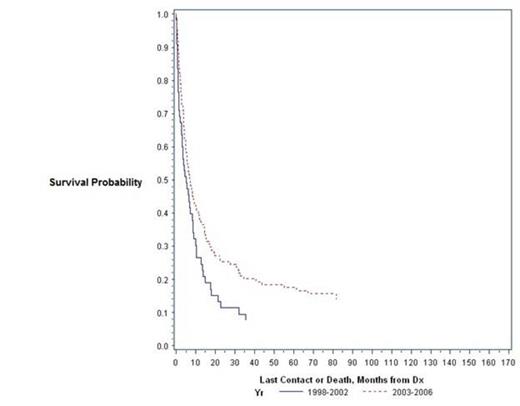Abstract
Background:
Enteropathy-associated T-cell lymphoma (EATL) is a very rare primary intestinal non-Hodgkin lymphoma (NHL) strongly associated with celiac disease. Previous studies suggest that EATL may be more common in Europe and among white population, in which celiac disease is a prevalent condition. However, comparative racial epidemiologic study of EATL in a large population is lacking and clinical studies remain limited to small series. Using two U.S. population databases, we determined the comparative incidences according to race and described the clinical features and outcome of the largest series of EATL reported to date.
Methods:
Incidence rates (case/1,000,000) were calculated using 2000-2010 data from the Surveillance, Epidemiology, and End Results (SEER) Program and age-adjusted to the U.S. 2000 standard population. Patient level data were obtained from the National Cancer Data Base (NCDB) Participant User File and analyzed for demographic patterns and stage distribution (1998-2011) as well as overall survival (1998-2006). SEER, a program of the U.S. National Cancer Institute, collects cancer incidence and survival data from population-based cancer registries covering approximately 28 percent of the U.S. population. NCDB, a joint program of the American College of Surgeons and the American Cancer Society, is a nationwide oncology outcomes database for more than 1,500 cancer programs in the U.S. and Puerto Rico capturing about 70% of all newly diagnosed cases of cancer in the U.S.
Results:
In the years 2000-2010, the overall incidence rate of EATL in the U.S. population was 0.111. Asians/Pacific Islanders had a higher incidence rate (0.236) compared to other races (whites [0.101], blacks [0.107], American Indians/Alaska natives [0.128]). The risk ratio of Asians compared to non-Asians was 2.32 (95% CI: 1.39-3.69; P =0.002). From 1998-2011, 515,026 patients were diagnosed with NHL and 337 (0.07%) had EATL. The median age was 64 years (range, 20 -90+ years) and 60% of patients were males. The stage distribution was as follows: I (26.7%), II (16.3%), III (3.3%), IV (29.1%), and unknown (24.6%). The median overall survival (OS) for the entire cohort was 5.9 months. Patients diagnosed in the more recent era (2003-2006) had a better outcome (median OS, 6.6 versus 2.6 months; Figure 1; P = 0.034). Asians/Pacific Islanders had a worse outcome compared to other races (Figure 2; P = 0.031). Multivariable analysis showed the following to be independent factors associated with inferior OS: age >60 years (HR: 1.49; 95% CI: 1.05-2.10), Asians/Pacific Islanders (HR: 2.27; 95% CI: 1.08-4.76), stage III/IV (HR: 3.03; 95%CI: 2.00-4.59), and diagnosis before 2003 (HR: 1.59; 95%CI: 1.10-2.28).
Conclusions:
Contrary to previous studies, we find that the highest incidence and lowest survival rates of EATL occur among Asians/Pacific Islanders, populations in which celiac disease is not considered to be prevalent. The overall survival of EATL patients has improved over time but remains poor.
No relevant conflicts of interest to declare.
Author notes
Asterisk with author names denotes non-ASH members.



This feature is available to Subscribers Only
Sign In or Create an Account Close Modal